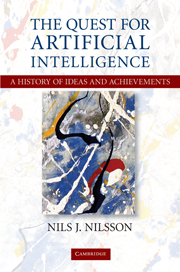Book contents
- Frontmatter
- Contents
- Preface
- PART I BEGINNINGS
- PART II EARLY EXPLORATIONS: 1950S AND 1960S
- PART III EFFLORESCENCE: MID-1960S TO MID-1970S
- PART IV APPLICATIONS AND SPECIALIZATIONS: 1970s TO EARLY 1980s
- 17 Speech Recognition and Understanding Systems
- 18 Consulting Systems
- 19 Understanding Queries and Signals
- 20 Progress in Computer Vision
- 21 Boomtimes
- PART V “NEW-GENERATION” PROJECT
- PART VI ENTR'ACTE
- PART VII THE GROWING ARMAMENTARIUM: FROM THE 1980s ONWARD
- PART VIII MODERN AI: TODAY AND TOMORROW
- Index
- Plate section
20 - Progress in Computer Vision
Published online by Cambridge University Press: 05 August 2013
- Frontmatter
- Contents
- Preface
- PART I BEGINNINGS
- PART II EARLY EXPLORATIONS: 1950S AND 1960S
- PART III EFFLORESCENCE: MID-1960S TO MID-1970S
- PART IV APPLICATIONS AND SPECIALIZATIONS: 1970s TO EARLY 1980s
- 17 Speech Recognition and Understanding Systems
- 18 Consulting Systems
- 19 Understanding Queries and Signals
- 20 Progress in Computer Vision
- 21 Boomtimes
- PART V “NEW-GENERATION” PROJECT
- PART VI ENTR'ACTE
- PART VII THE GROWING ARMAMENTARIUM: FROM THE 1980s ONWARD
- PART VIII MODERN AI: TODAY AND TOMORROW
- Index
- Plate section
Summary
Beginning aroud 1970 computer vision research grew into a highly developed subspecialty of AI, joining other specialized areas such as natural language processing, robotics, knowledge representation, and reasoning (to name just a few of them). In this chapter, I'll describe some of the important advances in computer vision during this period. Some of these were made in pursuit of specific applications in several fields such as aerial reconnaissance, cartography, robotics, medicine, document analysis, and surveillance.
Beyond Line-Finding
In an earlier chapter, I described some filtering techniques for enhancing image quality and for extracting edges and lines in images. But much more can be done to extract properties of a scene using specific information about the conditions under which images are obtained and general information about the properties of objects likely to be in the scene.
Shape from Shading
In what has been called a “back-to-basics” movement, researchers began investigating how information about the physics and geometry of light reflection from surfaces could be used to reveal three-dimensional properties of a scene from a single two-dimensional image. A leader in this study was Berthold K. P. Horn (1943-; Fig. 20.1). His MIT Ph.D. dissertation derived mathematical methods for determining the shape of an object from its shading.
- Type
- Chapter
- Information
- The Quest for Artificial Intelligence , pp. 258 - 270Publisher: Cambridge University PressPrint publication year: 2009



